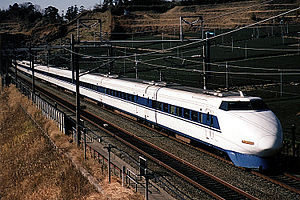| 100 series | |
|---|---|
 100 series set G47 on the Tokaido Shinkansen in January 2003 | |
| In service | 1 October 1985 – 16 March 2012 (26 years, 167 days) |
| Manufacturer | |
| Constructed | 1984–1992 |
| Refurbished | 2000–2004 |
| Scrapped | 1999–2012 |
| Number built | 1,056 vehicles (66 sets) |
| Number preserved | 5 vehicles |
| Formation | 4, 6, 12 or 16 cars per trainset |
| Fleet numbers |
|
| Capacity |
|
| Operators |
|
| Depots | Hakata |
| Lines served |
|
| Specifications | |
| Car body construction | Steel |
| Car length |
|
| Width | 3,383 mm (11 ft 1.2 in) |
| Height | 4,000 mm (13 ft 1 in) 4,488 mm (14 ft 8.7 in) (Bilevel car) |
| Doors | Two per side |
| Maximum speed |
|
| Traction system | Thyristor drive |
| Acceleration | 1.6 km/(h⋅s) (0.99 mph/s) for the former V sets) |
| Deceleration | 2.6 km/(h⋅s) (1.6 mph/s) |
| Electric system(s) | 25 kV AC, 60 Hz, overhead catenary |
| Current collector(s) | Pantograph |
| Bogies | DT202 (motored), TR7000 (trailer) |
| Safety system(s) | ATC-1 |
| Track gauge | 1,435 mm (4 ft 8+1⁄2 in) standard gauge |
The 100 series (100系, Hyaku-kei) was a Japanese Shinkansen high-speed electric multiple unit which operated between 1985 and 2012 on the Tokaido Shinkansen and Sanyo Shinkansen high-speed lines. They were introduced after the 200 series trains, but their numbering is such because in the days of Japanese National Railways (JNR), Shinkansen types running east of Tokyo were given even numbers and those west of Tokyo odd numbers, hence they were given the next odd number in line after 0, 100. The last remaining examples of the type were withdrawn from service following the last runs on 16 March 2012.